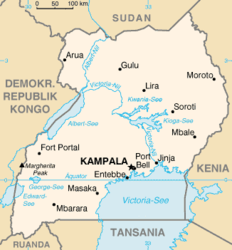Sebei people
The Sebei are a Southern Nilotic ethnic group inhabiting eastern Uganda. They speak Kupsabiny, a Nilotic language. The Sapiny occupy three districts, namely Bukwo, Kween and Kapchorwa.
 Map of Uganda, where most Sebei live | |
| Total population | |
|---|---|
| 300,000 (Uganda) | |
| Regions with significant populations | |
| Uganda | |
| Languages | |
| Sebei | |
| Religion | |
| Christianity, Traditional African religions |
Culture
The Sebei people lead fairly simple lives. The main structures of their lives are centered around cattle keeping, growing crops, and making beer. Common jobs held by the Sebei include cattle keepers and crop farmers. The jobs depend on where you live. Because of their fairly laid back culture, the need for major social structure is limited. There are not many criminal offenses that one could do. In Sebei culture, there are two levels of criminal offense. The highest level is for murder and physical assault, the lower level is for property or major civil disputes between people or groups of people.[1]
Locations
The Sebei live primarily on the slopes of Mount Elgon in eastern Uganda.[2] They number about 300,000 people and occupy an area of 1,730.9 square km in the districts of Bukwo, Kapchorwa and Kween. Their territory borders the Republic of Kenya which is a home to more than six million Kalenjin, a large ethnic group to which the Sebei belong. The Sebei, now known mainly as Sapiny, speak Kupsabiny, a Kalenjin language spoken by other smaller groups of Kalenjin stock around Mount Elgon. The Sebei and Kenyan smaller groups (Book, Kony, Mosoop, Someek, Bongomek) inhabiting the hills of Mount Elgon collectively are referred to as the 'Sabaots.[3][4]
In Uganda
The majority of the Sebei people live in the country of Uganda. The percent of the Ugandan population that is Sebei is only 0.6%; meaning that there are about 300,000 Sebei in Uganda.[5][6]
References
- "Demographics". www.daviddfriedman.com. Retrieved 2016-10-25.
- Goldschmidt, Walter; Gale Goldschmidt (1976). Culture and Behavior of the Sebei: A Study in Continuity and Adaptation. Berkeley, California: University of California Press. p. 11. Retrieved 11 September 2010.
- "The Sebei People and their Culture in Uganda". Go Visit Kenya. Retrieved 2020-05-25.
- "INTRA-ETHNIC RELATIONS AMONG THE SABAOT OF MT.ELGON, KENYA, 1945-2010" (PDF).
- "Sebei People and their Culture". Retrieved 2020-05-25.
- "Refugee Review Tribunal" (PDF).